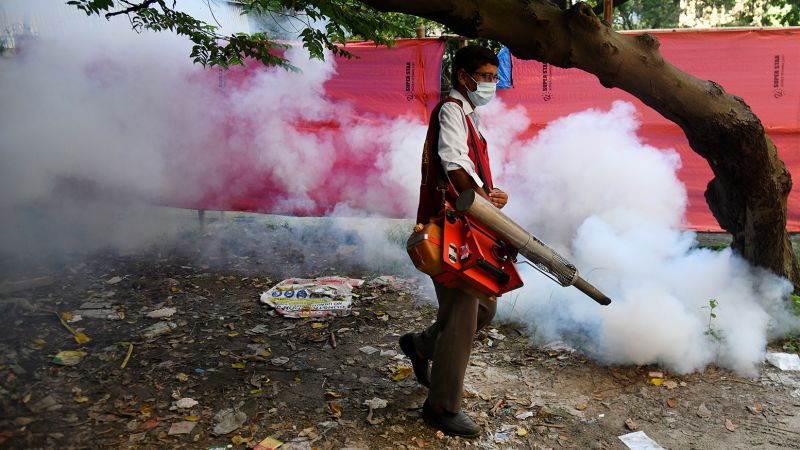Syed Mahmudur Rahman/NurPhoto/Gtty Images
A worker sprays mosquito repellent outside a hospital in Dhaka, Bangladesh, on September 9.
CNN
—
More than 1,000 people die from dengue fever Bangladesh’s worst outbreak of infection Official data shows temperatures are rising on record. climate crisis For the first time, more cases are being reported away from dense urban centers, fueling the ongoing spread of infection.
Since January, 1,017 people have died from the mosquito-borne disease, including more than 100 children, and the number of people infected has reached 200,000, according to Bangladesh Health Directorate statistics released on Monday. The number has increased to over 8,000 people.
Dengue fever is endemic in the South Asian country, and infections usually peak during the monsoon period from July to September, but this year the number of cases increased much faster, starting around the end of April.
Scientists say a long monsoon season, combined with warmer temperatures and erratic heavy rains, have created ideal breeding conditions for the Aedes mosquitoes that transmit dengue fever.
The influx of patients has strained the country’s medical system, with hospitals facing a shortage of beds and staff to treat patients, local media reported.
The death toll from the outbreak is almost four times higher than last year, when 281 people died. According to Bangladesh health authorities, more than 79,600 cases were reported in September alone, with 396 deaths.
There are also growing concerns that the outbreak could spread into cooler seasons. Last year, dengue cases only peaked in October, with most deaths recorded in November.
Munir Uz Zaman/AFP/Getty Images
Dengue fever patients receive treatment at Shaheed Suhrawardi Medical College Hospital in Dhaka on October 2.
Dengue fever, a viral infection, causes flu-like symptoms such as stabbing headaches, muscle and joint pain, fever, and in some cases, internal bleeding and death. The disease is transmitted to humans through the bite of an infected Aedes mosquito, and there is no specific treatment for the disease.
Dengue fever, also known as breakbone fever, is endemic in more than 100 countries and infects between 100 million and 400 million people each year, according to the World Health Organization (WHO).
In the past, outbreaks were usually confined to densely populated urban centers such as the capital Dhaka, home to more than 20 million people, but this year infections have spread rapidly to all districts of the country, including rural areas, WHO said. said.
WHO Director-General Tedros Adhanom Ghebreyesus said at a press conference last month that the UN agency is supporting the Bangladeshi government and authorities to “strengthen surveillance, testing capacity, clinical management, vector control, risk communication and community engagement” during the outbreak. He said he is doing so.
But domestic public health experts are calling for dengue to be given higher priority, focusing on preventive measures such as early detection and access to appropriate health services. Repeated dengue infections can be more severe and fatal.
This call to action is not limited to Bangladesh. As the planet heats up rapidly due to the burning of fossil fuels, outbreaks in new parts of the world will become more common.
According to the WHO, the number of dengue cases worldwide has already increased eightfold in the past 20 years.
As the climate crisis worsens, mosquito-borne diseases such as dengue, Zika, chikungunya and yellow fever are likely to spread further and have an ever-greater impact on human health.
Dengue fever has hit South America hard this year, with Peru battling its worst outbreak ever. In response to the outbreak in Florida, authorities have issued a warning to multiple counties. In Asia, the number of infected people is rapidly increasing in countries such as Sri Lanka, Thailand, and Malaysia. Outbreaks have also been reported in African countries south of Sarahan, such as Chad.
Mr. Abdi Mahmoud, WHO Head of Warning and Response called an outbreak He said it was a “canary in the coal mine of the climate crisis” and that more and more countries were experiencing the “burden of these diseases”.

